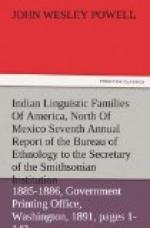[Footnote 60: Trans.
and Coll. Am. Antiq. Soc., 1836, vol.
II,
p. 133.]
So intimately associated with the Comanches have the Kiowa been since known to history that it is not easy to determine their pristine home. By the Medicine Creek treaty of October 18, 1867, they and the Comanches were assigned their present reservation in the Indian Territory, both resigning all claims to other territory, especially their claims and rights in and to the country north of the Cimarron River and west of the eastern boundary of New Mexico.
The terms of the cession might be taken to indicate a joint ownership of territory, but it is more likely that the Kiowa territory adjoined the Comanche on the northwest. In fact Pope[61] definitely locates the Kiowa in the valley of the Upper Arkansas, and of its tributary, the Purgatory (Las Animas) River. This is in substantial accord with the statements of other writers of about the same period. Schermerhorn (1812) places the Kiowa on the heads of the Arkansas and Platte. Earlier still they appear upon the headwaters of the Platte, which is the region assigned them upon the map.[62] This region was occupied later by the Cheyenne and Arapaho of Algonquian stock.
[Footnote 61: Pac. R. R. Rep., 1855, vol. 2, pt. 3, p. 16.]
[Footnote 62: Pike, Exp.
to sources of the Mississippi, App., 1810,
pt. 3, p. 9.]
Population.—According to the United States census for 1890 there are 1,140 Kiowa on the Kiowa, Comanche, and Wichita Reservation, Indian Territory.
KITUNAHAN FAMILY.
= Kitunaha, Hale in U.S. Expl. Exp., VI, 204, 535, 1846 (between the forks of the Columbia). Gallatin in Trans. Am. Eth. Soc., II, pt. 1, c, 10, 77, 1848 (Flatbow). Berghaus (1851), Physik. Atlas, map 17, 1853. Latham in Trans. Philolog. Soc. Lond., 70, 1856. Latham, Opuscula, 388, 1860. Latham, El. Comp. Phil., 395, 1862 (between 52 deg. and 48 deg. N.L., west of main ridge of Rocky Mountains). Gatschet in Mag. Am. Hist., 170, 1877 (on Kootenay River).
= Coutanies, Hale in U.S. Expl. Exp., VI, 204, 1846 (= Kitunaha).
= Kutanis, Latham, Nat. Hist. Man., 316, 1850 (Kitunaha).
= Kituanaha, Gallatin in Schoolcraft,
Ind. Tribes, III, 402, 1853
(Coutaria or Flatbows, north of lat. 49
deg.).
= Kootanies, Buschmann, Spuren der aztek. Sprache, 661, 1859.
= Kutani, Latham, El. Comp. Phil, 395, 1862 (or Kitunaha).
= Cootanie, Latham, El. Comp.
Phil., 395, 1862 (synonymous with
Kitunaha).
= Kootenai, Gatschet in Mag. Am.
Hist., 170, 1877 (defines area
occupied). Gatschet in Beach, Ind.
Misc., 446, 1877. Bancroft, Nat.
Races, III, 565, 1882.
= Kootenuha, Tolmie and Dawson, Comp.
Vocabs., 79-87, 1884 (vocabulary
of Upper Kootenuha).




